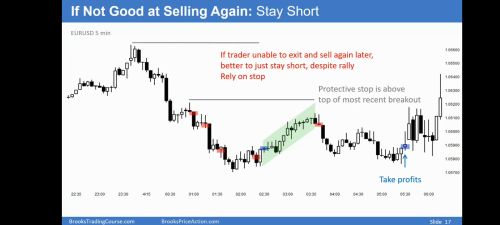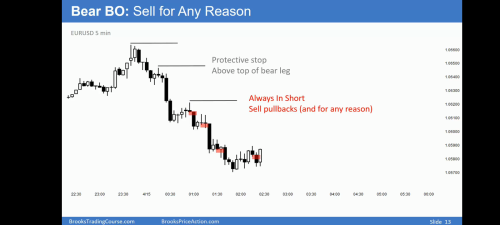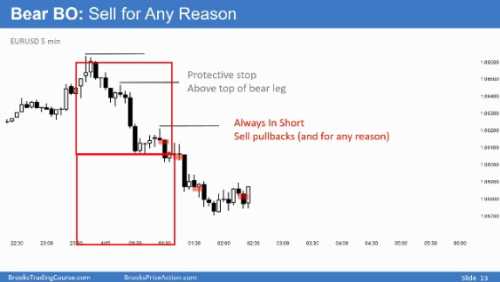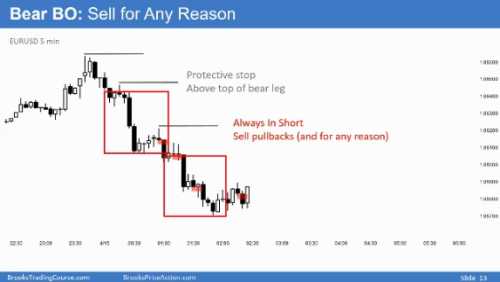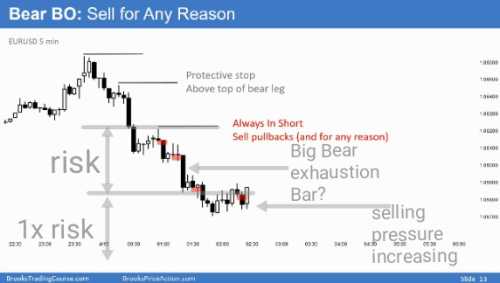The support forum is built with (1) General and FAQ forums for common trading queries received from aspiring and experienced traders, and (2) forums for course video topics. How to Trade Price Action and How to Trade Forex Price Action videos are consolidated into common forums.
Brooks Trading Course social media communities
If selling the second Bear leg (100am-230am) what is the profit target?
Looks like it already achieved MM leg 1=leg 2
Not sure what bar you are referring to.
The logic to any sell in this second leg is that it is a tight channel down and the first reversal will probably be minor so you can sell a PB and expect a test down.
Yet, if you have reasons to thing the move down is almost over, you can skip those sells and prepare yourself for taking the long. However, the MM projections are important but they are just one type of magnets among many and, for the MKT to reverse, it usually needs a cluster of them around the same price level or, else, at the MM there will be a PB but it will caused mainly by profit taking and, if so, the trend will continue down.
In short, the fact that you have a MM target does not mean, alone, anything, you need to see the full context and that is why picking the exact bottom in a trend reversal is low probability.
Before taking a trade, we need a reasonable trader's equation:
Risk/Reward/Probability
Risk is obvious, we know:
stop - entry = risk
Probability is more difficult. This example maybe is comparing buying vs selling pressure. If there's weak PB + strong leg down then estimate exhaustion vs another leg down.
Reward is estimating a reasonable profit target, like MM/ S&R points. How likely is 1x risk? 2x risk? Maybe each target different probability.
Correction on example slide:
*Buying pressure increasing
How likely is 1x risk? 2x risk? Maybe each target different probability.
Yes, different: 1x initial risk must be 60% and for 2x initial risk you need 40%. But remember that the trader's equation work with actual risk, so once your trade goes your way you can know the actual risk and adjust your targets, if wanted. When taking a swing trade at what can be the start of a new trend, I usually stick with 2 x initial risk but when the trend has gone for some bars, I scalp more and use actual risk for the swings.
Regarding the final 2 entries, what makes it high probability for 1x reward?
Because you are in a tight channel down so the first reversal is probably going to be minor and be followed by a test down. The problem with those sells is the TR PA and the fact that the trend has gone for some bars, so you can be selling low. For the reasons stated above, I would be using actual risk for swing trading or, more likely, scalping those trades. Anyway, you can take those sells and, if the MKT goes your way straight away, ok and you take your profit, else, you can sell more above and exit your full position once the MKT tests the low, or stay in the MKT for more down, if the bear trend continues.
But remember that the trader's equation work with actual risk, so once your trade goes your way you can know the actual risk and adjust your targets, if wanted.
I have to review actual risk videos again, but I remember disagreeing with it.
If the initial risk is 10 points then the trader is actually risking 10 points and will actually lose 10 points 40%-60% of the trades. Therefore, they need to make 1x-2x depending on probability to have a decent profit at the end.
Example: 100 trades
Actual risk: 10 points
40 win 20 points= 800 points
(win 2x actual risk)
60 lose 10 pts= -600 points
200 points profit.
I think he says 60% is break even with good management.
You have a whole section next discussing this topic. I would not agree nor disagree with Al without watching the full series first...
